pain guy
I have a suggestion for you: get your a son a "real" coach that knows what he is talking about and can help the boy
And by the way your "bio" on your site has no mention of your so called baseball background
Okay children, break it up, you're getting annoying with your personal attacks and what not.
You can stay on topic or act like idiots.
Chris believe he's onto something, not all of it is out of this world.
What's the deal with going, "Wow! You're such a loser your son will never amount to anything with you as his coach. ROFELF W#$T(O You're not helping any scouts what do you know" and it goes on, and on, and on, and if some of your kids could read what you write they'd be ashamed of you, or so I'd hope.
You can stay on topic or act like idiots.
Chris believe he's onto something, not all of it is out of this world.
What's the deal with going, "Wow! You're such a loser your son will never amount to anything with you as his coach. ROFELF W#$T(O You're not helping any scouts what do you know" and it goes on, and on, and on, and if some of your kids could read what you write they'd be ashamed of you, or so I'd hope.
XFACTOR
Chill a bit----my concern is that kids come on here looking for helpful information and listen to his dribble- he can hurt kids with his thinking and babbling---you know a lot of people believe what they read on the internet to be "gospel"---trust me --a lot of it ain't
Chill a bit----my concern is that kids come on here looking for helpful information and listen to his dribble- he can hurt kids with his thinking and babbling---you know a lot of people believe what they read on the internet to be "gospel"---trust me --a lot of it ain't
quote:Originally posted by TRhit:
Chill a bit----my concern is that kids come on here looking for helpful information and listen to his dribble- he can hurt kids with his thinking and babbling---you know a lot of people believe what they read on the internet to be "gospel"---trust me --a lot of it ain't
Please explain exactly how kids could be hurt (metaphorically or otherwise) by being encouraged to throw like...
- Greg Maddux
- Tom Glavine
- Nolan Ryan
- Roger Clemens
- Roy Oswalt
- Dan Haren
Well...they might have a natural M or inverted M and throw gas.
And when you're done with them they'll be injury free and accountants.
You call that good advise?
And when you're done with them they'll be injury free and accountants.
You call that good advise?
quote:Originally posted by thepainguy:quote:Originally posted by TRhit:
Chill a bit----my concern is that kids come on here looking for helpful information and listen to his dribble- he can hurt kids with his thinking and babbling---you know a lot of people believe what they read on the internet to be "gospel"---trust me --a lot of it ain't
Please explain exactly how kids could be hurt (metaphorically or otherwise) by being encouraged to throw like...
- Greg Maddux
- Tom Glavine
- Nolan Ryan
- Roger Clemens
- Roy Oswalt
- Dan Haren
Yeah, TPG, all those guys are accountants now aren't they??? LMAO
quote:Originally posted by thepainguy:quote:Originally posted by pops:
painguy, can you teach me how to play the bag pipes?
Not over the Internet.
Why not, you are trying to teach pitching over the internet.
Did you ever play the bag pipes?
Okay, the focus of the thread is changing dramatically.
....................Strike 2

....................Strike 2
TPG,
I'm curious as to why you include Haren on your list. If it is a list showing those who have compiled long successful careers. It seems he would be one of the studies rather than one who has proven your point.
Lifetime records
Maddux – 336-206
Glavine – 295-192
Ryan – 324-292
Clemens – 348-178
Oswalt – 104-49
Haren – 38-37
I'm curious as to why you include Haren on your list. If it is a list showing those who have compiled long successful careers. It seems he would be one of the studies rather than one who has proven your point.
Lifetime records
Maddux – 336-206
Glavine – 295-192
Ryan – 324-292
Clemens – 348-178
Oswalt – 104-49
Haren – 38-37
quote:Originally posted by PGStaff:
TPG,
I'm curious as to why you include Haren on your list. If it is a list showing those who have compiled long successful careers. It seems he would be one of the studies rather than one who has proven your point.
Lifetime records
Maddux – 336-206
Glavine – 295-192
Ryan – 324-292
Clemens – 348-178
Oswalt – 104-49
Haren – 38-37
I like Haren (and Oswalt) because their mechanics most closely resemble those of guys like Maddux, Glavine, Ryan, and Clemens. I mention them because I am always being asked by people which current pitchers their sons should emulate.
Infortunately, not everyone knows what I mean when I talk about the mechanics of Nolan Ryan or Tom Seaver, and video of them is harder to find. In contrast, it's much easier to see a game in which Haren or Oswalt is pitching.
Other younger pitchers whose mechanics like include...
- Johan Santana
- Zach Duke
- Daisuke Matsuzaka
I still mostly like Freddy Garcia, but I am concerned with how high his Pitching Arm Side elbow gets. I wonder if that may have something to do with the shoulder problems he has had.

I am concerned about Adam Wainwright for the same reason...
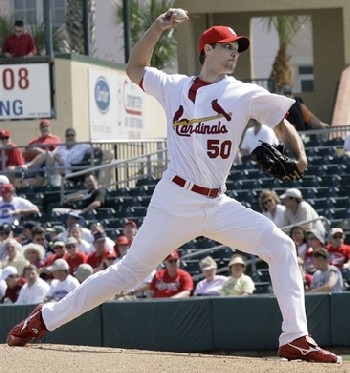
quote:Originally posted by pops:quote:Originally posted by thepainguy:quote:Originally posted by pops:
painguy, can you teach me how to play the bag pipes?
Not over the Internet.
Why not, you are trying to teach pitching over the internet.
Did you ever play the bag pipes?
It was a joke.
quote:noreast would like to take a moment and compliment TPG/CoachChris for his teflon shell and his sense of humor. You are cool under fire.
(ps. that doesn't mean I'm on board your ship) lol
Actually Pain I was wondering if you had thought about politics ?
quote:Actually Pain I was wondering if you had thought about politics ?
..........strike 2 1/2
pain,
On your website you say that
Yet just now you say
An oversight or what? Just trying to figure this out cause on your site you say he's got bad mechanics, yet now you're saying he's got good mechanics???
It just doesn't add up
On your website you say that
quote:If I am correct about this relationship, then I believe that a large number of pitchers are at an increased risk of experiencing serious problems with their Rotator Cuffs (especially subscapularis tears).
Professional pitchers that I believe are at an above-average risk of experiencing this problem, because they take their elbows both above and behind their shoulders, include...
* Scott Baker
* Jeremy Bonderman
* Matt Cain
* Jose Contreras
* Aaron Heilman
* Brandon McCarthy
* Ramon Ortiz
* Oliver Perez
* Sidney Ponson
* Anthony Reyes
* Johan Santana
* Jae Seo
* Matt Smith
* Jeff Weaver
* Dontrelle Willis
* Randy Wolf
* Joel Zumaya
Yet just now you say
quote:Infortunately, not everyone knows what I mean when I talk about the mechanics of Nolan Ryan or Tom Seaver, and video of them is harder to find. In contrast, it's much easier to see a game in which Haren or Oswalt is pitching.
Other younger pitchers whose mechanics like include...
- Johan Santana
- Zach Duke
- Daisuke Matsuzaka
An oversight or what? Just trying to figure this out cause on your site you say he's got bad mechanics, yet now you're saying he's got good mechanics???
It just doesn't add up
Doc
Pain guy doesnt add up !!!!!
Pain guy doesnt add up !!!!!
quote:Originally posted by Doc_K:
An oversight or what? Just trying to figure this out cause on your site you say he's got bad mechanics, yet now you're saying he's got good mechanics???
I need to update that page.
Basically, I have modified my view on Scapular Loading. Initially, I bought into Mike Marshall's idea that the elbows should never go behind the shoulders. Then I started to see pictures like this one of Greg Maddux...
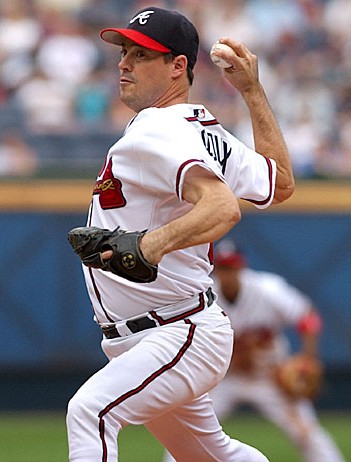
...and this one of Nolan Ryan...
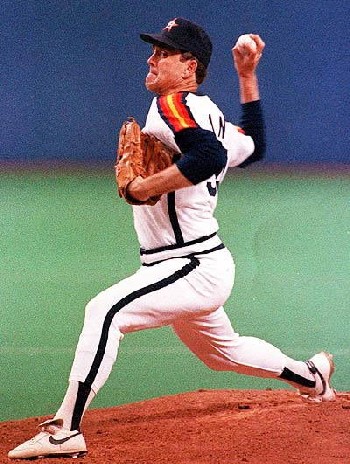
...and this one of Randy Johnson...
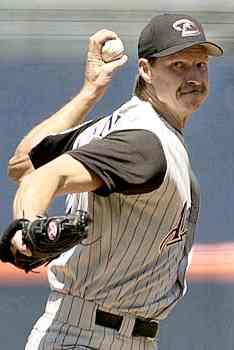
...and many others in which the PAS elbows of pitchers without serious shoulder problems are obviously going behind their shoulders.
I have since come to believe that Dr. Marshall is wrong about this and have modified my opinion and have come to believe that the problem is when the elbows go both above and behind the level of the shoulders like Mark Prior is doing in the photo below...
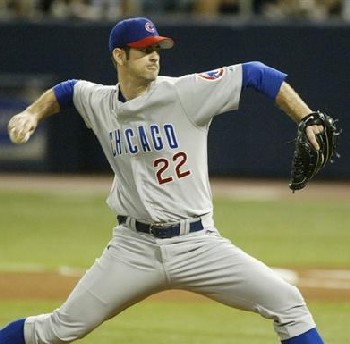
As a result, I have also removed Dontrelle Willis from that list...
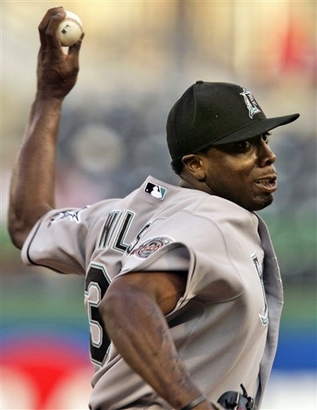
...because, while his elbows do get a bit high earlier on in his delivery, I believe that what he is doing in the photo above should be safe.
PAIN GUY
Another dumb question:
What background do you have to make these assertions from JUST pictures and videos ?
Give us something to believe in because right now you are doing what anyone can do-- or you just like every other cyberspace cowboy leading people astray
LIke I Have said people take what is on the internet to be "gospel" and you are using that fact to spew your dribble
Another dumb question:
What background do you have to make these assertions from JUST pictures and videos ?
Give us something to believe in because right now you are doing what anyone can do-- or you just like every other cyberspace cowboy leading people astray
LIke I Have said people take what is on the internet to be "gospel" and you are using that fact to spew your dribble
I'm sure I should already know this, but I wanted to be sure that I'm up to speed on a couple of terms regarding arm action, pronation vs. suppination.
If you extend your arm out in front of your body with your thumb pointing straight up as if you were hitch hiking or giving someone a thumbs up: the rotation from that point to where your palm faces the ground is pronation and the rotation from that beginning point to where your palm faces the sky is suppination. Is that correct? Thanks
If you extend your arm out in front of your body with your thumb pointing straight up as if you were hitch hiking or giving someone a thumbs up: the rotation from that point to where your palm faces the ground is pronation and the rotation from that beginning point to where your palm faces the sky is suppination. Is that correct? Thanks
quote:Originally posted by TRhit:
What background do you have to make these assertions from JUST pictures and videos ? Give us soneting to believe in because right now you are doing what anyone can do
I have spent the last 2 years reading all of the research behind pitching mechanics, kinesiology, physiology, and injuries. I have about 5 feet of articles, when stacked on end. I have also spent a lot of time comparing 2 groups of pitchers...
1. Those who had long, relatively-injury free careers.
2. Those who had injury-plagued careers.
...looking for differences (mechanical and otherwise) between those two groups.
While my work is still unfinished and controversial, I have been complimented on it and urged to continue this project by...
1. Former professional baseball players (just got an e-mail yesterday).
2. D1 and other coaches.
3. Orthopedic surgeons.
4. Writers like Will Carroll.
I think I have managed to get Will to move away from advocating the Inverted W and instead advocate the Horizontal W or the plain old W (which is what Maddux does).
Also, my opinions about the shoulder in particular are bolstered by general advice about how to keep your rotator cuff healthy. For example, see...
- Keep Your Shoulders In The Safe Zone
quote:Originally posted by Emanski's Heroes:
I'm sure I should already know this, but I wanted to be sure that I'm up to speed on a couple of terms regarding arm action, pronation vs. suppination.
If you extend your arm out in front of your body with your thumb pointing straight up as if you were hitch hiking or giving someone a thumbs up: the rotation from that point to where your palm faces the ground is pronation and the rotation from that beginning point to where your palm faces the sky is suppination. Is that correct? Thanks
Correct.
Thumb up as when hitch-hiking is supination.
Thumb down as when pouring out a can of beer is pronation.
Pronation is better than supination, assuming the pronation is done at the correct moment in time.
pain guy
with all the accolades please list a few of them
Hey I got an email this morning as well
As I said previously any one with a semblance of intelligence can read on the internet and "REGURGITATE" it all in different words==I sometimes wonder if the "REGURGITATER" even knows what he is writing about
Do get what I am saying?
with all the accolades please list a few of them
Hey I got an email this morning as well
As I said previously any one with a semblance of intelligence can read on the internet and "REGURGITATE" it all in different words==I sometimes wonder if the "REGURGITATER" even knows what he is writing about
Do get what I am saying?
Chris. Was this ortho aware of what I've pointed out many times to you? What I mean is that this position of "hyperabduction" in the M or inverted W happens for only a brief moment in the delivery and that any forward motion of the humerus or any external rotation of the humerus is very, very small while the arm is in that position. Any forward motion of the humerus or significant external rotation happens AFTER the humerus has already dropped to shoulder height, or lower, in some instances.quote:Originally posted by thepainguy:
Here's an e-mail I recently received discussing the Inverted W and my theory of Hyperabduction...
Chris I am an orthopedic surgeon, and would like to offer you a theory on why the inverted W is bad to the long term health of the shoulder.
In the position of hyper abduction, elevation and extension of the distal humerus above the shoulder (inverted W) the inferior glenohumeral ligament is placed on stretch. The humeral head must lever against it to advance the arm forward. This ligament is the primary anterior stabilizer of the glenohumeral joint with the arm elevated (i,e. pitching). In other words, this position places this ligament under tension, then it is levered against in order to throw. This eventually will either loosen the shoulder, or tear the anterior labrum. It should be recognized this ligament is under stress during the "normal" delivery. If you traumatically dislocate your shoulder, this ligament is a key part of the pathology. Shoulder instability in turn leads to impingement, and other problems. Conversely, when the elbow is below the shoulder, this ligament would not be as stressed.
Also, the specific use and timing of the muscles about the shoulder is critical. They have done muscle activity studies during throwing, and there are distinct differences between amateurs and professionals. There is also evidence for muscle use differences in the healthy shoulders, and the ones that aren't.
I am not a shoulder guru, certainly not a pitching guru, but am interested in pitching mechanics. Like you, I learned from others while coaching little league/AAU, and agree there is a lot of misinformation out there.
Isn't the internet a wonderful place for wannabees? 
(Wonder if Gotwood can find a picture of a wannabee for us?)
(Wonder if Gotwood can find a picture of a wannabee for us?)
Cant help but read all you guys bashing each other and think, "Oh how a little knowledge can cause a world of trouble."
You guys need to just wake up and realize that there are several techniques that work. Yes, all the way to the major league level.
And anytime I hear "my 10 year old has great mechanics so he doesn't stress the elbow or shoulder" I have to laugh at how little you know about the pediatric skeletal system and anatomy.
You can't throw a ball without transfer of forces through the joints. Joints that have open growth plates on any child under 16-18. You really need to see the damage that the traction forces on the medial elbow and compressive forces at the lateral elbow can do to a growth plate.
You guys need to just wake up and realize that there are several techniques that work. Yes, all the way to the major league level.
And anytime I hear "my 10 year old has great mechanics so he doesn't stress the elbow or shoulder" I have to laugh at how little you know about the pediatric skeletal system and anatomy.
You can't throw a ball without transfer of forces through the joints. Joints that have open growth plates on any child under 16-18. You really need to see the damage that the traction forces on the medial elbow and compressive forces at the lateral elbow can do to a growth plate.
quote:Originally posted by dm59:
Chris. Was this ortho aware of what I've pointed out many times to you? What I mean is that this position of "hyperabduction" in the M or inverted W happens for only a brief moment in the delivery and that any forward motion of the humerus or any external rotation of the humerus is very, very small while the arm is in that position. Any forward motion of the humerus or significant external rotation happens AFTER the humerus has already dropped to shoulder height, or lower, in some instances.
Yes.
As I have said multiple times elsewhere, while in some cases (e.g. probably Dontrelle Willis but I don't have any video of him) the elbow does indeed drop before the external rotation occurs, in other cases it does not. Instead, it stays elevated as the external rotation begins. Here are two examples...
- Anthony Reyes
- Adam Wainwright
However, if you look at guys like...
- Greg Maddux
- Nolan Ryan
- Roger Clemens
- Randy Johnson
...the elbow never gets that high. That suggests to me that a high elbow is not necessary to throwing hard (or well).
Also, the hyperabduction of the Pitching Arm Side elbow sets up an extraordinarily long and foreceful external rotation of the Pitching Arm Side upper arm (e.g. 180+ degrees versus a more typical 90 degrees) which I believe increases the load on both the elbow and the shoulder.
I believe that this is the root cause of the problems experienced by...
- Mark Prior
- Francisco Liriano
quote:You guys need to just wake up and realize that there are several techniques that work.
Nice you have posted 7 times and you are telling guys like TR, BBscout ....... to wake up. Interesting.
Reyes' elbow actually does drop between frames 38 and 39. Wainwright? Maybe a little high, but for how long? Now we're down to your theory being for just those specific ones who actually do have the elbow that high during any serious motion of the humerus. How many of those are there? Not all of the ones you've been showing in stills over the past couple of years.quote:Originally posted by thepainguy:Yes.
As I have said multiple times elsewhere, while in some cases (e.g. probably Dontrelle Willis but I don't have any video of him) the elbow does indeed drop before the external rotation occurs, in other cases it does not. Instead, it stays elevated as the external rotation begins. Here are two examples...
Actually, my question was really if the ortho you quoted has been made aware of the fact that the elbow actually drops before the real motion begins.
As you know, I happen to agree with you that the M just might be more stressful on the tissues involved because of the distance the external rotation happens over in a very short period of time. I have no proof but that's a potential thought for discussion. I just have problems with your claims of the M being so problematic simply because of the fact that, at one instant in the motion, the elbow is up there. Your language has been such that this one thing is the problem. This is probably only the second time I've seen you agree with what I've been saying for so long about this position only not being the problem because the elbow drops.
quote:Reyes' elbow actually does drop between frames 38 and 39.
In relation to the background Reyes elbow appears to drop about a foot...
quote:Originally posted by dm59:
Reyes' elbow actually does drop between frames 38 and 39.
My problem with Reyes' PAS elbow is how high it is between frames 37 and 38. His shoulders are turning and his PAS upper arm is externally rotating while it is still quite elevated. Yes, it does drop significantly by frame 41, but IMO that is too late to keep him from being vulnerable to impingement problems.
quote:impingement problems.
What is the relationship of impingement problems with rotater cuff/ ulner nerve...ect....--Serious question-- because I have never heard of a pitcher on the DL with an impingement (not saying it hasnt happened) injury, unless the impingement leads to something else.
Painguy....
A knuckle curve is NOT thrown like a fastball.
A knuckle curve is NOT thrown like a fastball.
quote:Originally posted by BobbleheadDoll:quote:You guys need to just wake up and realize that there are several techniques that work.
Nice you have posted 7 times and you are telling guys like TR, BBscout ....... to wake up. Interesting.
Ha, that is funny. Your amount of posts on this board is what qualifies you as knowing what you are talking about?
Did I post something that was incorrect? I don't care how many forum posts you have.
I didn't single out any of the members you named. I said you guys and was talking about the crabbing matches those members where having about w vs. m vs. circular. I figured they would know who I meant.
Sorry bob but if you think there is one technique that is a sure fire success you are blind.
And if you think that just because someone is new to the board they don't know anything you are more than just blind.
Sorry to anyone else who was offended.
I actually wrote my post after reading only the first 2 pages. So I never even read anything from TR or BBscout. "Most" of the early bickering I was talking about was painguy and chameleon.
quote:Originally posted by deemax:quote:impingement problems.
What is the relationship of impingement problems with rotater cuff/ ulner nerve...ect....--Serious question-- because I have never heard of a pitcher on the DL with an impingement (not saying it hasnt happened) injury, unless the impingement leads to something else.
Impingment is when the muscle/tendons of the rotator cuff (usually the supraspinatus or infraspinatus are compressed between the greater tubercle of the humerus and the acromion. This happens normally at around 120 degrees of shoulder abduction. It can be a genetic condtion or overuse/poor mechanics. Like elbow higher then the shoulder during overhead throwing. It leads to a lot of pain and possible rupture of the tendons if not treated properly and the mechanism of injury fixed. It can become chronic in the form of tendonosis and usually is followed by a rupture in that case due to the build up of scar tissue in the tendon.
Ulnar nerve entrapment can happen at the thoracic outlet (TOS) where it can be compressed by the scalene muscles of the neck. At the elbow as it runs along the olecranon in its groove or under the pronator teres muscle. Ulnar nerve is your "funny bone". It can also be compressed at the wrist. Very similar to carpal tunnel syndrome but it affects the pinky and ring finger instead of the thumb/index/middle fingers. Those are the median nerve. Throwing can create traction to the ulnar nerve at the medial elbow.
When you hear a pitcher has shoulder/rotator tendonitis or inflammation, its normally impingment syndrome that they have.
quote:Like elbow higher then the shoulder during overhead throwing.
Can you elaborate on this...higher then the shoulder based on the horizon, or higher based on a linear path between the shoulders....
quote:Originally posted by Gameth:
Impingment is when the muscle/tendons of the rotator cuff (usually the supraspinatus or infraspinatus are compressed between the greater tubercle of the humerus and the acromion. This happens normally at around 120 degrees of shoulder abduction. It can be a genetic condtion or overuse/poor mechanics. Like elbow higher then the shoulder during overhead throwing. It leads to a lot of pain and possible rupture of the tendons if not treated properly and the mechanism of injury fixed. It can become chronic in the form of tendonosis and usually is followed by a rupture in that case due to the build up of scar tissue in the tendon.
Ulnar nerve entrapment can happen at the thoracic outlet (TOS) where it can be compressed by the scalene muscles of the neck. At the elbow as it runs along the olecranon in its groove or under the pronator teres muscle. Ulnar nerve is your "funny bone". It can also be compressed at the wrist. Very similar to carpal tunnel syndrome but it affects the pinky and ring finger instead of the thumb/index/middle fingers. Those are the median nerve. Throwing can create traction to the ulnar nerve at the medial elbow.
Nicely done, Gameth. These are both solid explanations. You must have some medical knowledge if not background.
I would add that impingement is a theory and IMO has more to do with shoulders than elbows.
People aren't exactly sure what the precise cause of shoulder problems is, but the theory is that in certain orientations of the shoulder, muscles can rub against bones and be weakened that way. You can also put muscles and ligaments in mechanically problematic positions that can make them more vulnerable to injury.
In terms of elbows, IMO impingement is less of a problem at the beginning of an injury and more of a problem when the UCL starts to let go and the elbow joint starts to loosen up. In that case, too much stress can be placed on structures like the Ulnar Nerve as things in the elbow start to float around and get out of place due to the laxity of the joint.
quote:Originally posted by deemax:quote:Like elbow higher then the shoulder during overhead throwing.
Can you elaborate on this...higher then the shoulder based on the horizon, or higher based on a linear path between the shoulders....
As Einstein said, it's all relative.
It has nothing to do with the person's orientation relative to the ground.
Instead, what matters is what's going on relative to the other anatomy of the shoulder. The reference point that I use is the top of the Acromial processes, which is the bony bump at the top of the shoulder. Another reference point is to draw a line perpendicular to the spine at the base of the neck.
Because of this, interpreting whether someone's elbows are above the level of their shoulders can get a bit tricky. I have personally been fooled by guys like Dontrelle Willis and Randy Johnson who lean forward during their stride. That can make their elbows look higher than they actually are. Their elbows ARE high relative to the ground, but that doesn't matter. What matters is that they are below the level of their shoulders.
The photo below of Randy Johnson is a good example of this. Notice how he's leaning forward toward 1B. That means that while his elbows are high up in the air, they are still below the level of his shoulders (as measured by a line perpendicular to his spine whose origin is the top of the neck of his jersey).

quote:Originally posted by itrogas44:
Painguy....A knuckle curve is NOT thrown like a fastball.
As I have come to learn, there are at least 3 pitches that are called a knuckle curve. One is thrown like a fastball, One is thrown like a standard curve, and one is thrown like a knuckleball.
quote:Their elbows ARE high relative to the ground, but that doesn't matter. What matters is that they are below the level of their shoulders.
Do you have any examples of pitchers who get their elbow higher then the relative shoulder hieght?
quote:Originally posted by deemax:quote:Their elbows ARE high relative to the ground, but that doesn't matter. What matters is that they are below the level of their shoulders.
Do you have any examples of pitchers who get their elbow higher then the relative shoulder hieght?
Joel Zumaya...

Billy Wagner...

Adam Wainwright...

Aaron Heilman...

Anthony Reyes...

I thought you were talking about here...
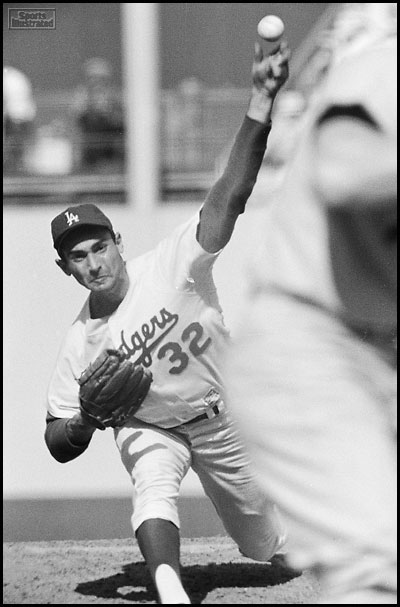
not here


not here



